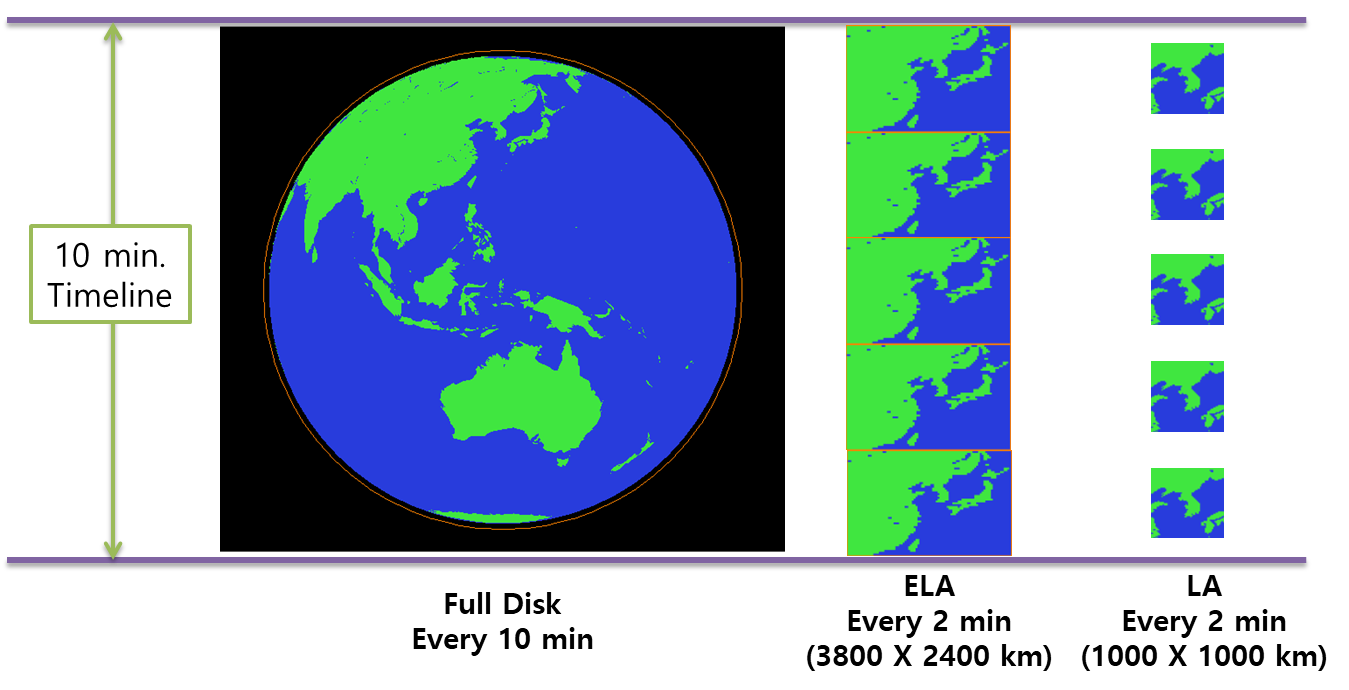Introduction
Request-based high frequency regional observation
Geo-Kompsat-2A AMI Rapid Scan (ARS) Service Description
1. Introduction
The Advanced Meteorological Imager (AMI) on board the GEO-KOMPSAT-2A (GK2A) is capable of frequent and flexible observations, providing full-disk images of the Earth every 10 minutes and regional images at shorter intervals (see Figure 1). Full-disk and other regional observations have spatial resolutions ranging from 0.5 to 2 km, with spectral coverage incorporating 16 channels.
 Figure 1: GK2A AMI observation sequence within a 10-minute time frame
Figure 1: GK2A AMI observation sequence within a 10-minute time frame
For regional monitoring, target area (TA) observation provides imagery covering a 1,000 × 1,000 km area every 2 minutes, with location change flexibility to support the national and international services of KMA. Local area (LA) observation typically focuses on observing the Korean peninsula but can also be customized upon request for TA observation. The GK2A ARS service allows National Meteorological and Hydrological Services (NMHSs) to request particular TA observations by leveraging location flexibility on an international scale.
2. Service Request Guidelines
2.1 Service Overview
The GK2A ARS service allows NMHSs (users, individually referred to as “user”) in the GK2A coverage area to request specific areas and times for TA observation.
2.2 Basic Principles
I. The requests of users may be rejected or suspended depending on circumstances within Korea or KMA.
II. The service is provided on a best effort basis, considering operational limitations.
III. User requests related to emergency operations for tropical cyclones and volcanic eruptions are given priority over other requests.
IV. The tracking observation period does not exceed 24 hours initially. The maximum period for fixed observation is seven days, but it may be extended upon additional request.
2.3 Request Management
All users, including those in the RA II and RA V, should submit their requests directly to KMA via a dedicated web page. In the event of conflicting requests from different users, KMA shall assign priority in line with the Basic Principle III above. If this is not feasible, KMA shall assign priority at its discretion. Section 2.5 provides detailed related to request management.
2.4 Registration
Before using the service, users must submit a completed registration form that includes the email address to which requests will be sent in order to enable validation by KMA.
2.5 Request Procedure
To request the service, users should use the dedicated website and provide a registered email address based on the observation center information, as well as the desired start and end time. Once registration is completed, users in RA II and RA V can request the service on the dedicated web page. (http://datasvc.nmsc.kma.go.kr/datasvc/html/special/specialReqMain.do). The request procedure is as follows (see Figure 2):
 Figure 2: Request procedure for users in RA II and RA V
Figure 2: Request procedure for users in RA II and RA V
2.6 Service Availability
The GK2A ARS service is available 24/7 and will be provided as soon as possible. The request procedure typically takes one working day but may take up to three days.
3. Data Access
Observation data for the target area can be accessed through the NMSC web page or Real-time FTP Service (RFS). Related imagery (imagery products and observation area) is also available on the GK2A AMI real-time image website.
4. Feedback
Once the requested observation is completed, users will be asked to provide feedback to KMA on how the observation data were used.
5. Reference Site
Emergency Support Mechanism of FENGYUN Satellite (FY ESM) [CMA]
URL: http://nsmc.org.cn/service/en/emergency/index.html
Himawari Request [JMA]
URL: https://www.jma.go.jp/jma/jma-eng/satellite/HimawariRequest.html